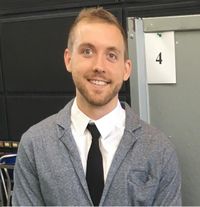CAZypedia needs your help! We have many unassigned GH, PL, CE, AA, GT, and CBM pages in need of Authors and Responsible Curators.
Scientists at all career stages, including students, are welcome to contribute to CAZypedia. Read more here, and in the 10th anniversary article in Glycobiology.
New to the CAZy classification? Read this first.
*
Consider attending the 15th Carbohydrate Bioengineering Meeting in Ghent, 5-8 May 2024.
Difference between revisions of "User:Alex Anderson"
Harry Brumer (talk | contribs) (Created page with "200px|right '''This is an empty template to help you get started with composing your User page.''' You should begin by opening this page for ed...") |
Harry Brumer (talk | contribs) m (Text replacement - "\^\^\^(.*)\^\^\^" to "$1") |
||
| (9 intermediate revisions by 2 users not shown) | |||
| Line 1: | Line 1: | ||
| − | [[Image: | + | [[Image:Aa.jpg|200px|right]] |
| − | |||
| − | + | Alex Anderson recieved his BScH from Wilfrid Laurier University (Canada) in 2017, and began his foray into microbiology as a diagnostic laboratory technician at the Public Health Ontario Laboratories where he became fascinated with microbial cell surface structure and function. Alex completed his MSc in 2019 the lab of Dr. [[User:Joel Weadge|Joel Weadge]], alongside [[User:Michael Suits|Michael Suits]], at WLU where he studied the structure and function of CAZymes responsible for the biosynthesis, modification and export of cellulosic materials involved in biofilm formation in Gram-negative pathogens. Alex is currently a PhD candidate in the lab of Dr. [[User:Anthony Clarke|Anthony Clarke]] at the University of Guelph where he studies the mechanism of peptidoglycan O-acetylation in Gram-negative bacteria. | |
| + | |||
| − | + | Alex and colleagues have demonstrated the structures of: | |
| − | |||
| − | |||
| − | |||
| − | |||
| + | CAZy-unclassified ''Escherichia coli'' phosphoethanolamine transferase BcsG (6PCZ/6PD0) <cite>Anderson2020</cite> | ||
| + | [[GH5]] ''Clostridioides difficile'' endo-β-glucanase CcsZ (6UJE/6UJF) <cite>Scott2020</cite> | ||
| + | |||
---- | ---- | ||
<biblio> | <biblio> | ||
| − | # | + | #Anderson2020 pmid=32152228 |
| + | #Scott2020 pmid=33264329 | ||
| + | </biblio> | ||
| − | |||
<!-- Do not remove this Category tag --> | <!-- Do not remove this Category tag --> | ||
[[Category:Contributors|Anderson,Alex]] | [[Category:Contributors|Anderson,Alex]] | ||
Revision as of 14:34, 18 December 2021
Alex Anderson recieved his BScH from Wilfrid Laurier University (Canada) in 2017, and began his foray into microbiology as a diagnostic laboratory technician at the Public Health Ontario Laboratories where he became fascinated with microbial cell surface structure and function. Alex completed his MSc in 2019 the lab of Dr. Joel Weadge, alongside Michael Suits, at WLU where he studied the structure and function of CAZymes responsible for the biosynthesis, modification and export of cellulosic materials involved in biofilm formation in Gram-negative pathogens. Alex is currently a PhD candidate in the lab of Dr. Anthony Clarke at the University of Guelph where he studies the mechanism of peptidoglycan O-acetylation in Gram-negative bacteria.
Alex and colleagues have demonstrated the structures of:
CAZy-unclassified Escherichia coli phosphoethanolamine transferase BcsG (6PCZ/6PD0) [1]
GH5 Clostridioides difficile endo-β-glucanase CcsZ (6UJE/6UJF) [2]
- Anderson AC, Burnett AJN, Hiscock L, Maly KE, and Weadge JT. (2020). The Escherichia coli cellulose synthase subunit G (BcsG) is a Zn(2+)-dependent phosphoethanolamine transferase. J Biol Chem. 2020;295(18):6225-6235. DOI:10.1074/jbc.RA119.011668 |
- Scott W, Lowrance B, Anderson AC, and Weadge JT. (2020). Identification of the Clostridial cellulose synthase and characterization of the cognate glycosyl hydrolase, CcsZ. PLoS One. 2020;15(12):e0242686. DOI:10.1371/journal.pone.0242686 |
